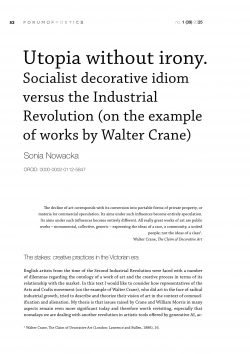
Sonia Nowacka
A b s t r a k t
This paper aims to explore the intersections of art, socialism, and the Industrial Revolution in the theoretical writings of Walter Crane, with particular emphasis on his conception of the ontology of art and its relationship to the commodity form. A central issue for Crane – an artist and theorist affiliated with the nineteenth-century Arts and Crafts movement – is the status of ornamentation, which he regarded as a socially significant art form in decline under industrial conditions. By the late nineteenth century, decorative art in England had become an important idiom for socially engaged artists – among the first in Europe to systematically theorize their opposition to industrialization and its detrimental effects on human creativity. In this paper, I argue that the aspirations of the Arts and Crafts movement, when examined alongside the austere aesthetics of socialist realism in twentieth-century Central and Eastern Europe, as well as the broader anti-ornamental turn of the early twentieth century, illuminate how conceptions of art – and the utopian visions of ideal society they often entailed – have shifted over time. On one hand, this study seeks to familiarize Polish readers with the theoretical underpinnings of the Arts and Crafts movement, which has often been sidelined in favour of more canonical aesthetic programs. On the other, it offers a philosophical inquiry into the ontology of art under conditions of rapid industrialization – an inquiry that continues to inform contemporary debates on the status of the artwork within market-driven cultural economies.





